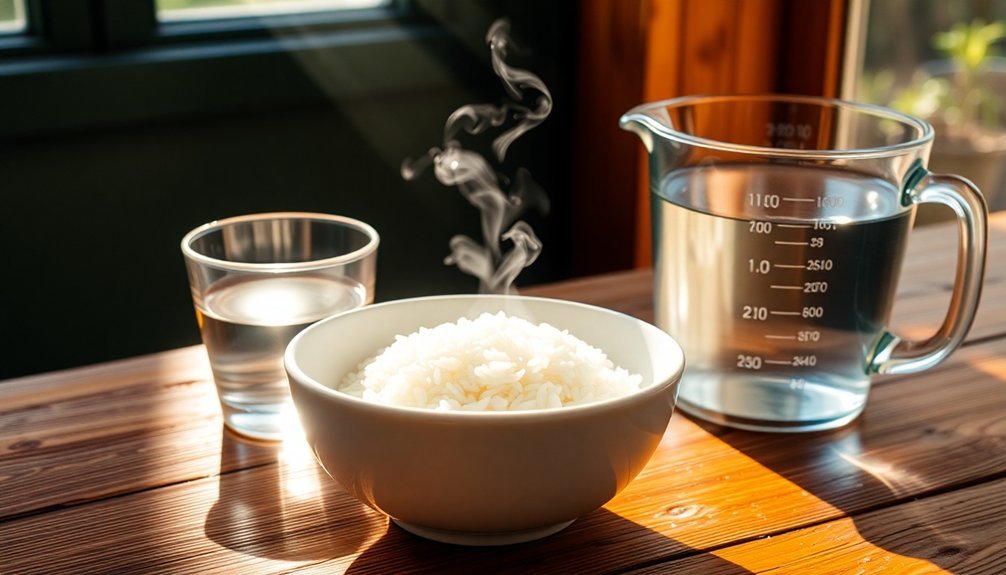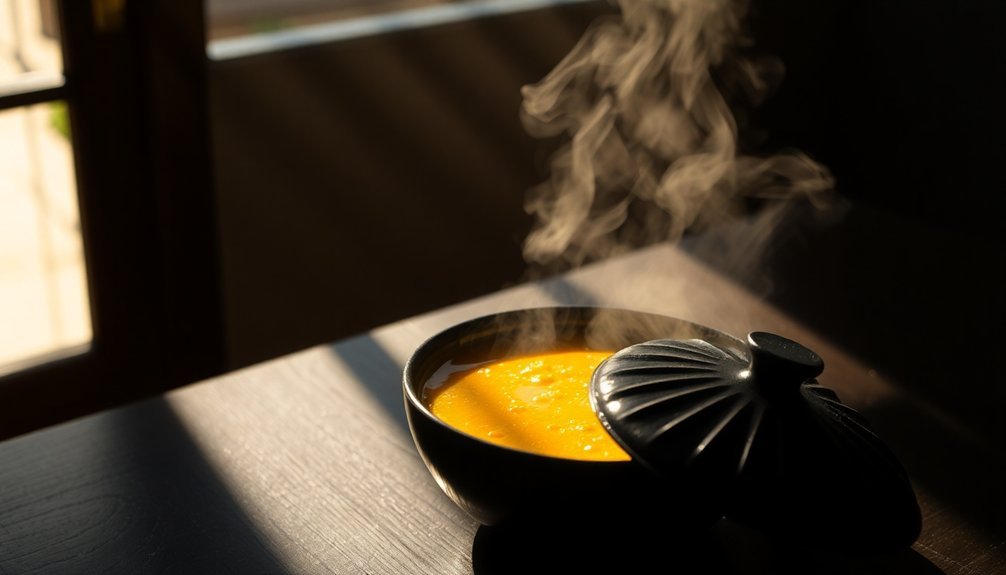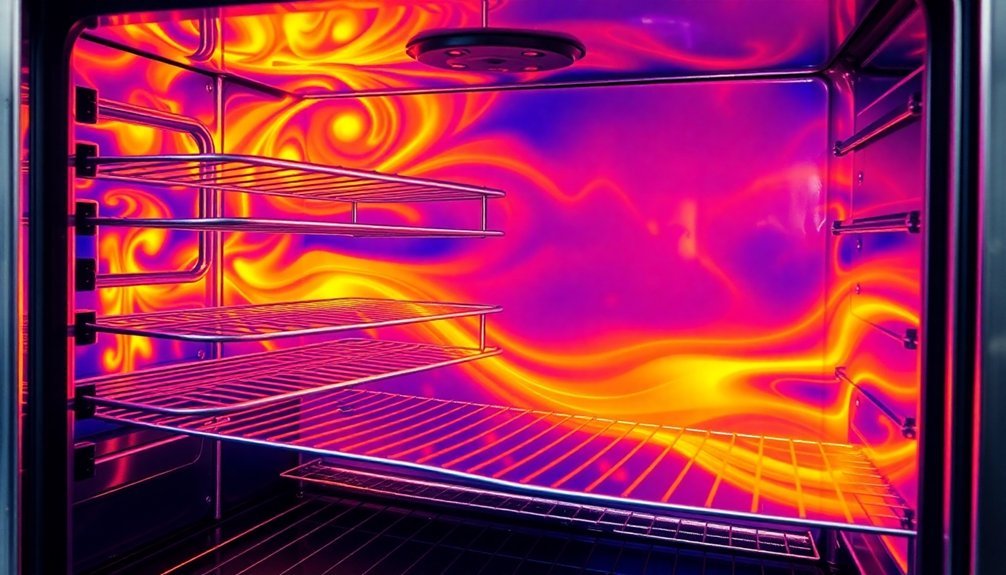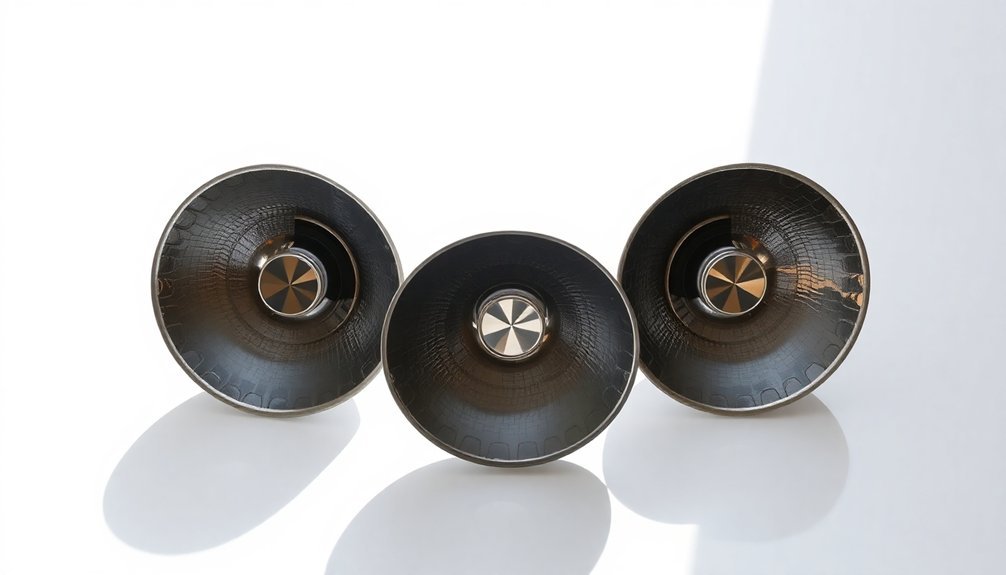To cook rice in a solar cooker, you'll want to start with the basic 1:1 ratio (one cup rice to one cup water) and add an extra 1/4 to 1 cup of water depending on your conditions. If you're using an indirect solar system or cooking in high temperatures, add more water to account for increased evaporation. Your location, season, and altitude will affect the exact amount needed – arid regions and high elevations typically require more water. For best results, use dark-colored pots with tight-fitting lids and cook between 11 AM and 3 PM. Understanding your specific environmental factors will help you master the perfect solar rice ratio.
Understanding Basic Solar Rice Ratios

Success in solar rice cooking begins with mastering the fundamental water-to-rice ratio. While the basic principle starts with a 1:1 ratio of rice to water, you'll need to make specific adjustments for solar cooking methods. Since solar cookers heat more slowly than conventional methods, you'll typically need to add between half to one full measure of extra water to achieve perfect results.
When you're using a solar cooker, remember that liquids don't evaporate as much as they do in traditional cooking methods. For a standard cup of rice, you'll want to use about 1-1/4 cups of water, though you may need to reduce the liquid by 1/4 to 1/2 cup compared to conventional cooking methods. The absorption method is particularly well-suited for solar cooking, allowing the rice to slowly absorb the water as it heats.
Your specific solar cooker type will influence these measurements – parabolic cookers might require ratios closer to traditional cooking, while box ovens and panel cookers typically need less liquid.
To guarantee success, you'll want to use a dark pot with a tight-fitting lid and consider enclosing it in a clear, heat-resistant plastic bag to trap heat effectively. This approach works well with various rice types, from Japanese round rice to basmati, ensuring properly cooked, fluffy grains.
Solar Cooking Time Variables
You'll find that solar cooking times vary considerably with seasonal changes in light intensity, from shorter cooking periods during summer's peak sunlight to longer durations in winter months.
The heat retention capabilities of different solar cooker types directly impact your cooking duration, with well-insulated box ovens maintaining consistent temperatures while panel cookers require more time due to heat loss.
The water quantity adjustments are essential when switching from conventional to solar cooking methods.
To achieve the best results, you should plan your rice cooking during peak sun hours (typically 10 AM to 2 PM) when solar energy is strongest and most consistent.
Seasonal Light Intensity Factors
Understanding seasonal light intensity plays an essential role in successful solar cooking. You'll find the most effective cooking window between 11:00 am and 3:00 pm when the sun is directly overhead.
During winter months, you'll need to adjust your cooker more frequently as the sun sits lower on the horizon, while summer offers longer unattended cooking times due to the sun's higher position.
Your geographic location greatly impacts solar cooking success. While areas like Southern Arizona provide ideal conditions, coastal regions and places with frequent cloud cover present more challenges. For optimal results, you should use hot tap water when preparing rice in your solar cooker.
You'll need to plan accordingly based on your local climate and seasonal variations.
- Prime cooking hours shrink during fall and winter, requiring earlier start times around 10:00 am
- Summer months offer extended cooking windows with higher temperatures
- Your cooker's effectiveness depends on proper sun tracking and frequent angle adjustments
- Local weather patterns directly affect cooking times and temperatures
To maximize your rice cooking results, make sure you're positioning your solar cooker to face the sun directly during peak hours.
Using reflectors and transparent surfaces can help compensate for lower light intensity during challenging seasons or in less ideal locations.
Heat Retention Differences
Now that you're familiar with seasonal lighting patterns, let's examine how different solar cookers retain heat – a vital factor affecting your cooking times.
Your cooker's design greatly impacts how well it maintains temperature. Dark-colored cooking vessels and interior surfaces will absorb more sunlight, converting it efficiently into heat.
You'll want to make certain your cooker has proper insulation – whether it's foam, fiberglass, or even newspaper – to prevent heat from escaping into the atmosphere. A tight-fitting transparent lid is essential, as it allows sunlight to enter while trapping the valuable heat inside.
To maximize heat retention, you'll need to position your reflective surfaces correctly. These surfaces concentrate sunlight and help maintain consistent temperatures, but they're only effective when properly aligned with the sun.
You'll need to adjust your cooker every few hours to follow the sun's movement. Don't forget to protect your setup from wind, as it can quickly dissipate accumulated heat. Place your cooker in an unshaded area and use windbreaks when necessary.
These factors directly influence how long it'll take to cook your rice to perfection.
Peak Cooking Hours
Taking full advantage of solar cooking requires careful attention to daily and seasonal timing. You'll get the best results when cooking rice during peak sunlight hours between 11 AM and 3 PM, when the sun is directly overhead. During these hours, the sun's rays hit your solar oven at the ideal angle, maximizing heat absorption and cooking efficiency.
To achieve consistent cooking results with your rice, consider these essential timing factors:
- Position your solar oven in direct sunlight, away from any shade or obstacles that could block the sun's rays.
- Monitor weather conditions closely, as cloudy or overcast skies will greatly extend cooking times.
- Adjust your cooking schedule seasonally, as summer months provide more intense sunlight and longer peak hours.
- Check your location's sun angle throughout the day, repositioning the oven as needed to maintain ideal exposure.
If you're cooking rice outside these peak hours, you'll need to compensate by adding extra cooking time.
Remember that desert and high-altitude locations typically offer better solar cooking conditions due to clearer skies and more direct sunlight exposure.
Seasonal Water Adjustments

During each season, the amount of water needed for perfect rice can vary considerably. While the basic ratio remains 1:1, you'll need to make adjustments based on seasonal factors that affect cooking conditions.
In spring and summer, you'll likely need to add more water than the standard 1/4 cup adjustment per cup of rice. Higher temperatures increase evaporation rates, and warm air can speed up water absorption. If you're cooking in a particularly humid environment, you might need to reduce this extra amount slightly to prevent mushy rice.
Fall and winter typically require less additional water due to lower evaporation rates. You'll find that the standard 1/4 cup adjustment works well, or you might even reduce it slightly. Indoor heating during colder months creates a more controlled environment, which helps maintain consistent cooking conditions.
Your location also plays a vital role in determining the perfect ratio. If you're in an arid region, you'll need more water to combat high evaporation.
At higher altitudes, you'll want to adjust for lower boiling points, while coastal areas might require modifications due to higher humidity levels.
Direct Vs Indirect Sunlight
Sunlight patterns significantly affect your rice-to-water ratio when using solar cooking methods.
In direct sunlight cooking, you'll need less water due to faster cooking times and higher temperatures that can exceed 200°C. The concentrated solar radiation reduces evaporation time, maintaining a typical 1:1.5 rice-to-water ratio similar to traditional cooking methods.
Indirect sunlight cooking, however, may require slightly more water due to longer cooking times and lower peak temperatures. When using thermal storage systems, you'll want to adjust your ratio to approximately 1:1.75 to account for extended heat exposure and gradual evaporation.
Key factors to take into account when adjusting your rice-to-water ratio:
- Direct sunlight cookers need frequent repositioning but maintain consistent cooking temperatures, allowing for standard water ratios.
- Indirect systems offer more flexibility with cooking times but may require additional water due to longer exposure.
- Thermal storage in indirect systems helps maintain steady temperatures, reducing the risk of burning or undercooking.
- Cloud cover and diffuse light conditions will affect cooking times and water requirements, particularly in direct solar systems.
Remember to monitor your rice during the cooking process and adjust ratios based on your specific solar cooker type and environmental conditions.
Equipment and Container Selection

Your choice of container material plays an essential role in achieving perfectly cooked rice, with dark-colored enamel or non-reactive pots being ideal for maximum heat absorption in solar cooking.
You'll want to guarantee your container has a snug-fitting lid and is made of materials that can effectively retain and distribute heat throughout the cooking process.
The container's heat distribution features, such as thick walls and proper insulation, will help maintain consistent temperatures and prevent hot spots that could lead to unevenly cooked rice.
Container Material Matters
Selecting the right container material plays an essential role in achieving perfect rice every time. When cooking rice using solar power, you'll want to choose containers that maximize heat retention and distribute it evenly. Dark-colored, non-reflective materials are your best bet, as they absorb and retain heat more effectively than their lighter counterparts.
For optimal results with solar-cooked rice, consider these important material characteristics:
- Cast iron or thick-walled pots provide superior heat retention and even distribution, guaranteeing your rice cooks uniformly.
- Non-stick coatings prevent rice from sticking to the bottom and make cleanup much easier.
- Dark or black containers specifically designed for solar cooking absorb maximum heat from your solar setup.
- Durable materials that can withstand high temperatures while remaining lightweight enough for practical use.
When selecting your rice cooking container, verify it's compatible with your specific solar cooking method. If you're using a solar generator with an electric rice cooker, confirm that your cookware matches the power output capabilities.
Remember that materials with high thermal mass will help maintain consistent cooking temperatures, which is essential for perfectly cooked rice. For best results, choose containers that feature energy-saving designs or built-in insulation.
Heat Distribution Features
Building on the importance of container materials, proper heat distribution features directly impact your rice cooking success. When using a solar cooker, you'll want to guarantee even heating throughout your rice container. The pot's design should include high-quality insulation and heat-retaining properties to maintain consistent temperatures during the cooking process.
| Feature | Purpose | Impact on Rice |
|---|---|---|
| Insulated Walls | Maintains stable temperature | Prevents uneven cooking spots |
| Heat-Retaining Base | Concentrates heat distribution | Guarantees thorough grain cooking |
| Reflective Surface | Maximizes heat absorption | Speeds up cooking process |
| Sealed Lid Design | Traps steam and heat | Creates perfect rice texture |
Position your solar cooker to capture maximum sunlight, typically facing south for prime exposure. You'll achieve the best results when temperatures reach between 65°C to 400°C, depending on your solar cooker type. For consistent rice cooking, parabolic or vacuum tube designs work exceptionally well as they concentrate sunlight effectively. Remember to adjust your cooker's position throughout longer cooking sessions to maintain steady temperatures, especially if you're preparing larger portions of rice.
Rice Types for Solar Cooking
Discovering the right rice variety for solar cooking can considerably impact your results. You'll find that certain types of rice perform better in solar cookers due to their natural characteristics and cooking properties. Japanese round rice, Thai rice, jasmine rice, and basmati rice are all excellent choices for your solar cooking adventures.
When selecting rice for your solar cooker, look for varieties that offer:
- Even water absorption throughout the cooking process
- Grains that remain separate and don't clump together
- A fluffy texture when fully cooked
- Natural resistance to becoming mushy
You'll want to take into account how your chosen rice variety adapts to different solar cooker types. Whether you're using a parabolic, box oven, or panel cooker, the rice should respond well to gradual heating. Long grain brown rice works particularly well in solar cookers because it maintains its structure during the extended cooking time.
Remember to adjust your cooking approach based on your specific solar cooker. Some models distribute heat more efficiently than others, so you'll need to monitor the cooking process and stir occasionally to guarantee even results.
Temperature and Climate Considerations

Temperature and weather patterns play an essential role in successful solar rice cooking. You'll need to maintain temperatures between 180°F to 200°F (82°C to 93°C) for ideal results, which you can achieve through different solar cooker types.
Parabolic cookers offer quick cooking times of 20-30 minutes, while box cookers take longer but provide more consistent heat.
To maximize your solar cooking efficiency, you'll want to focus on proper insulation using materials like aluminum foil or rockwool around the cooking cavity. This helps maintain stable temperatures, especially important when you're cooking rice.
You should also position your cooker according to your geographical location – face it southward and adjust the tilt angle based on your latitude.
Weather conditions will greatly impact your cooking time. You'll need to account for cloud cover, wind, and available sunlight hours.
In temperate regions, you can boost performance by using reflectors, particularly if you position them to catch morning or afternoon sun.
For reliable results, consider using stored heat methods that can maintain cooking temperatures for 3-4 hours, which provides a backup during inconsistent weather conditions.
Optimal Cooking Window Planning
Planning your rice's cooking window strategically can make the difference between perfectly cooked grains and a disappointing result. You'll need to allocate approximately 18 minutes for active cooking time on low heat after reaching the initial boil, followed by an essential 10-minute resting period where the rice continues to steam under the lid.
To achieve ideal results, you'll want to take into account these important timing elements:
- Don't lift the lid during cooking, as this releases valuable steam and disrupts the careful water-to-rice ratio you've established.
- Account for about a quarter cup of water evaporation during the cooking process, regardless of your batch size.
- Plan for proper resting time, which guarantees the rice fully absorbs remaining moisture and achieves perfect texture.
- Factor in your rice's age when planning, as older rice requires longer cooking times and more water.
Remember to wrap your pot with a heavy lid to minimize evaporation during cooking. If you're using a rice cooker, follow the manufacturer's guidelines, but still maintain the importance of the resting period for ideal results.
This attention to timing will help you achieve consistently perfect rice with well-separated, fluffy grains.
Testing and Perfecting Methods

Scientific testing reveals that traditional rice-cooking wisdom doesn't always hold up under scrutiny. The popular knuckle method, in particular, shows significant inconsistencies due to natural variations in finger length.
Tests demonstrate that a 6mm difference in finger segments can alter water volume by up to 42 teaspoons, leading to unpredictable results.
You'll achieve more consistent results by using precise ratios instead of finger measurements. For standard stovetop cooking, start with a 1:1 ratio of water to rice by volume, plus an additional quarter cup to account for evaporation. This extra amount remains constant regardless of batch size, as evaporation doesn't scale proportionally with quantity.
To perfect your method, consider that rice gelatinization occurs between 154°F and 174°F, with ideal results at boiling point (212°F). You can improve consistency by wrapping your pot to limit evaporation and using a cast iron pan for even heat distribution.
If you're using different cooking methods, adjust your ratios accordingly – pressure cookers like the Instant Pot work best with a 1:1 ratio due to their sealed environment.
Frequently Asked Questions
Can Leftover Solar-Cooked Rice Be Safely Stored and Reheated?
You can safely store solar-cooked rice in airtight containers. Cool it quickly, refrigerate within an hour, and consume within 4 days. When reheating, guarantee it reaches 165°F and only reheat once.
Does Altitude Affect the Water Ratio When Cooking Rice With Solar Energy?
You don't need to adjust your rice-to-water ratio for altitude when solar cooking. While altitude affects cooking time and boiling points, you'll still use the standard 1:1.25 ratio regardless of your elevation.
How Does Cloud Cover Impact the Rice-To-Water Ratio During Cooking?
When there's cloud cover, you'll need less water since evaporation rates decrease. You should reduce your usual water ratio by 10-15% to prevent soggy rice, as clouds trap moisture and slow evaporation.
Can Solar Cooking Work With Pre-Seasoned or Flavored Rice Varieties?
Yes, you can solar cook pre-seasoned rice, but you'll need to adjust water ratios and expect milder flavors. It's best to add extra seasonings after cooking to maintain the desired taste intensity.
Should Rice Be Pre-Soaked Before Solar Cooking in Colder Climates?
Yes, you'll want to pre-soak your rice in colder climates. It helps reduce cooking time, guarantees even cooking, and improves digestibility. Soaking for 6-24 hours works best, especially for brown rice varieties.
In Summary
You'll find that a 1:2 rice-to-water ratio works best for most solar cooking situations, but don't be afraid to adjust based on your specific conditions. Keep track of your local climate, season, and rice type to fine-tune this ratio. If you're cooking in indirect sunlight or cooler temperatures, you might need to add an extra 1/4 cup of water to achieve perfectly tender results.





Leave a Reply